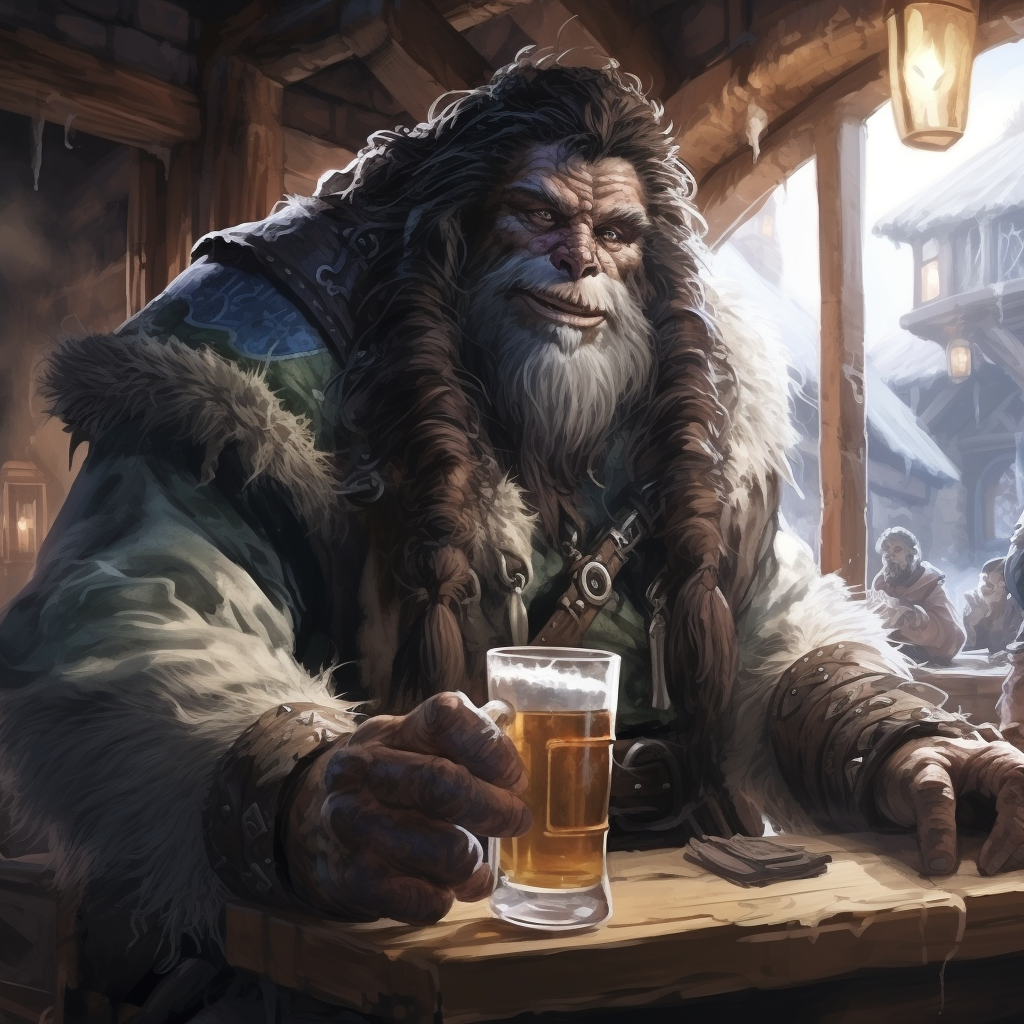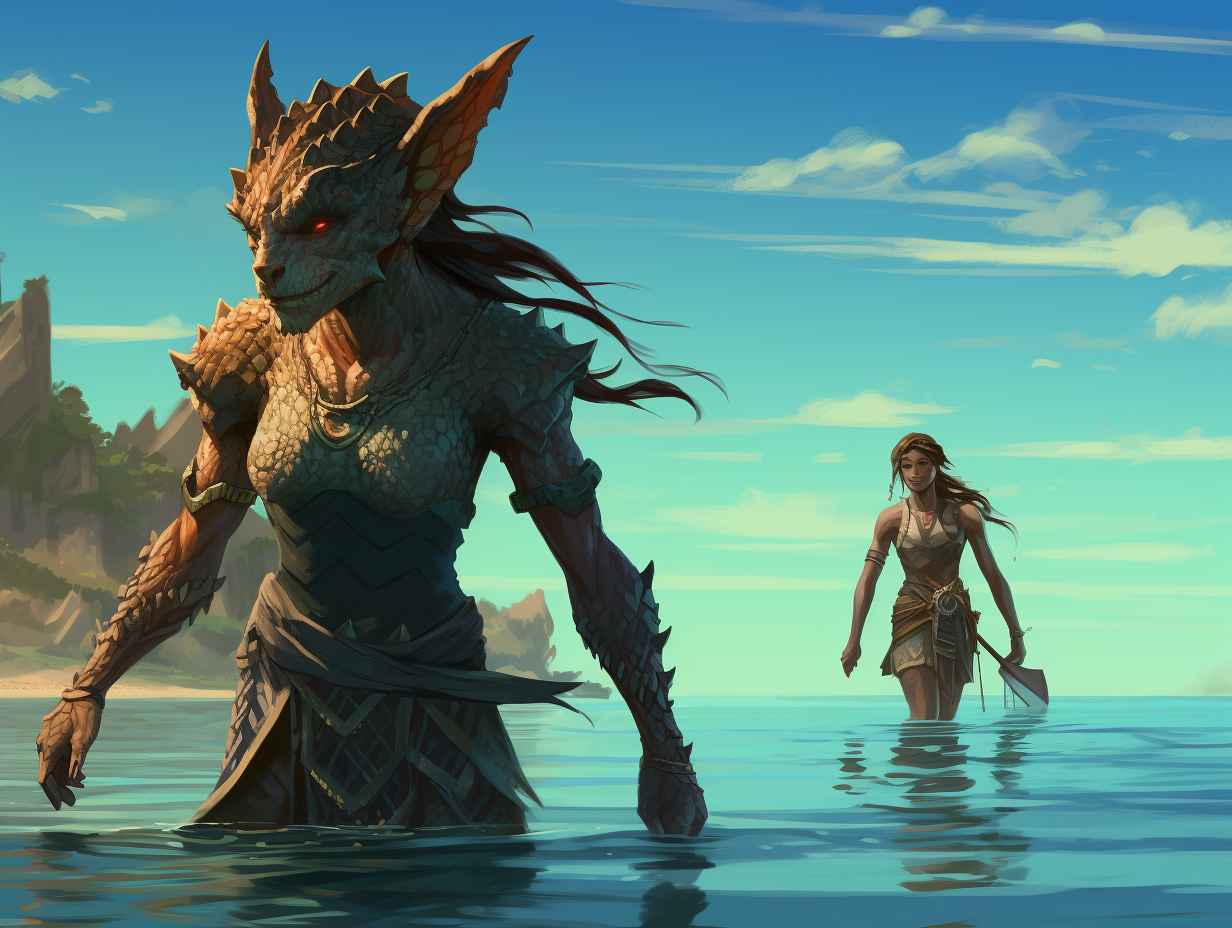




Garden Gnome
The first gnomes to venture beyond the material plane and into the Feywild were welcomed by the cunning archfey witch Grezelda who soon enslaved the entire race, forcing them to work in her gardens. There, the gnomes developed an eternal feud with the tricksy pixies, fairies, and sprites who enjoyed nothing more than seeing a garden gnome take a tumble. The gnomes soon employed their ingenuity to craft traps for the fey creatures. Emboldened by their success, the gnomes created a sophisticated trap for their captor Grezelda. Caught in the trap, the dying Grezelda uttered one last curse, turning all the gnomes into stone.
Surprising Souvenirs
Later visitors to the Feywild encountered these statues. Whenever a traveler brought one back to the material plane as a souvenir, its curse was broken, allowing the gnome to reanimate at will.
Fearful of enslavement, garden gnomes cling to the magic of their erstwhile curse, turning themselves to stone whenever unknown creatures come near. Many owners of garden gnome statues have no idea their statues are, in fact, living gnomes, who, in a cooperative relationship with their unwitting hosts, wage an endless battle against encroaching rodents, pesky insects, pernicious weeds, and the occasional belligerent fey creature begging for a prank war.
Crochety Caretakers
Versus the ancient relatives the rock and forest gnomes, garden gnomes tend to be rounder, and grumpier in their comportment. They enjoy the simple joys of life, such as sitting on a toadstool and eating a sandwich, or kicking back for a well-deserved nap in a meticulously-kept garden, free from pixies, ground squirrels, weeds, and other pests.
As adventurers, garden gnomes are often out to seek a new home after the destruction of their previous garden. Others are driven to adventure by pride and vendettas against old enemies, or to seek a cure for a pernicious plant disease.
Traits
Type
You are humanoid.
Size
You are small.
Speed
Your walking speed is 25 feet.
Small nature (Optional)
To emphasize your unique heritage, add +1 to your Dexterity score (max 17 at 1st level) and -1 to your Strength score.
Garden Cunning
You have proficiency in your choice of Nature or Animal Handling and you have advantage on Nature and Animal Handling checks toward plants, fey creatures, and small or tiny beasts.
Prank War Magic
You know the mage hand cantrip, typically used for causing annoyance, frustration, distraction, or embarrassment to a trespasser.
Starting at 3rd level you can cast alarm without material components. Starting at 5th level you can cast the spell magic mouth. You can optionally cast the magic mouth spell without material components, in which case the spell duration is 24 hours.
Once you cast any of these leveled spells with this trait, you can’t cast that spell with it again until you finish a long rest. You can also cast these spells using any spell slots you have of the appropriate level.
Intelligence, Wisdom, or Charisma is your spellcasting ability for your racial spells when you cast them with this trait (choose when you select this race).
Born of Stone
As a reaction to seeing a creature target you with an attack, as a bonus action on your turn, or as a reaction to you succeeding on a Dexterity saving throw, you can turn to stone. You can use this trait a number of times equal to your proficiency bonus. When you do so, you specify when you want to revert to flesh: “quickly” (1 minute), “in a bit” (1 hour), or “when I’m good and ready” (completion of a long rest). While in stone form you are Petrified and have 17 AC. (Your weight only doubles.) If a creature attempts to rouse you, for instance by speaking your name or tapping your statue, your alarm spell is triggered, or if you take damage, you can use your reaction to revert from stone to flesh.



Race: Sea Kobold
Reptilian kobolds, with their cold-blooded bodies and long tails were naturals for delving into the depths in search of treasure. Magically transformed by powerful denizens of the deep into aquatic creatures, sea-going kobolds are not only amphibious, but can survive underwater and at great depths indefinitely.
Rivals of sea elves, merfolk, and tritons for territory and resources, sea kobolds seek lost ships, explore sunken cities and delve into flooded labyrinths seeking legendary treasure for the dragon turtles they revere. Sea kobolds have been known to make villages on the backs of dragon turles.
Primal Hunters
Unlike land-based kobolds who thrive at trap making, sea kobolds embrace a more primal lifestyle centered on the glory of the hunt—for both prey and treasure.
Though small in size, aquatic kobolds are effective as hunters, using their predator’s reflexes and pack coordination to trap schools of fish, or bring down even much larger prey such as plesiosaurs, by latching on by the dozens with their razor-sharp claws.
Undersea Survivors
Sea kobolds that venture from their undersea societies may be ferrying treasures to be sold in port cities, or seeking lore regarding a sunken wreck. Sea kobolds may start adventuring as guides for sea-faring voyages, as escapees from merfolk or triton prison mining camps, or as spies or ambassadors to the overworld.
Traits
Type
You are humanoid.
Size
You are small.
Speed
Your walking speed is 30 feet, and you have a swimming speed equal to your walking speed.
Child of the Sea
You can breathe air and water, and you have resistance to cold damage.
Darkvision
You can see in dim light within 60 feet of you as if it were bright light, and in darkness as if it were dim light. You discern colors in that darkness only as shades of gray.
Pack Pursuit
You were born with instincts for hunting quick-moving prey such as schooling fish. When a creature within 15 feet of you disengages from combat with another creature or takes movement that provokes an attack of opportunity, you can use your reaction to move up to half of your speed in pursuit of the creature and attempt to grapple it.
Sea Kobold Legacy
You gain one of the following traits of your choice.
Snatcher
While grappled by you, a creature takes 1d4 + your Strength modifier piercing damage at the start of each of its turn from your tenacious claws and fanged jaws.
Slippery Scout
You can add +1d6 to Dexterity (Stealth) checks and Dexterity (Acrobatics) checks to escape a grapple. You can use this trait a number of times equal to your proficiency bonus. You regain all uses when you finish a long rest.
Delver in the Depths
You can cast detect magic with this trait, without requiring a material component. Starting at 3rd level, you can also cast locate object with it, without requiring a material component. Once you cast either of these spells with this trait, you can’t cast that spell with it again until you finish a long rest. You can also cast these spells using spell slots you have of the appropriate level. Intelligence, Wisdom, or Charisma is your spellcasting ability for these spells when you cast them with this trait (choose when you select this race).





Yeti
Mysterious, reclusive, and the subject of rumor, myth, prejudice and wonder, the yeti live in remote highlands where wind-blown snow and ice obscure their tall, lumbering white-furred forms.
Fierce or Friendly?
Yeti survive in small clans in homes of carved ice and chiseled stone. Yeti are believed to prey on creatures such as mountain goats (and possibly travelers), though some are rumored to keep yak herds. Travelers to these remote regions tell as many tales of ferocious Yeti attacks as they do unexplained rescues. It is unknown whether the difference is due to the incoherent memories of half-frozen travelers, or whether yeti clans differ drastically in their approach to dealing with trespassers.
Lonely Questers
Yeti sometimes join groups of adventurers as guides or to deal with a common threat such as a white dragon or an orc invasion. Perhaps the most common yeti sightings are of adolescent yeti on journeys of self-discovery. Some scale high mountains to test their limits. Others dare to venture into the lowlands to glimpse the strange, complex, and hostile world of humans, elves, and dwarves. Yet others undertake a quest to obtain rare items to benefit their village, or complete a quest to aid or obtain allies.
Traits
Type
You are humanoid.
Size
You are medium.
Big Feet
Your walking speed is 35 feet, thanks to your long, lumbering steps. Terrain made difficult by snow or ice does not cost you extra movement.
Darkvision
You can see in dim light within 60 feet of you as if it were bright light and in darkness as if it were dim light. You discern colors in that darkness only as shades of gray.
Wild Instinct
You can add 1d6 to Perception, Survival, Stealth, and Athletics checks. You can use this trait a number of times equal to your proficiency bonus. You regain all uses when you finish a long rest.
Furry Form
You have resistance to cold damage.
Powerful Build
You count as one size larger when determining your carrying capacity and the weight you can push, drag, or lift.
Yeti Lineage
When you select this race, choose one of the following traits.
Wrath of the Yeti
You have fangs that you can use to bite a creature you have grappled. When you make a fangs attack as an unarmed strike on a creature you have grappled, you do so with advantage. On a hit, your fangs deal 1d6 + your Strength modifier piercing damage to the grappled creature and you have advantage to maintain the grapple on that creature until the start of your next turn.
Gift of the Yeti
While you are carrying a creature, it gains resistance to cold damage. You also know the cantrip spare the dying. Intelligence, Wisdom, or Charisma is your spellcasting ability for this trait (choose when selecting this race).









Version History
| Date | Version | Change |
|---|---|---|
| 2025.01.28 | 1.1 | nerf garden gnome small nature feature due to min-max abuse potential |
| 2023.12.12 | 1.0 | Initial release on gmbinder. Art credits: Midjourney tool (v5). Feel free to use the art for noncommercial purposes. |
Feedback Please!
Have questions, comments, playtest feedback, or requests for additional content or changes?
I need your feedback!
Contact me at adventure@authordanallen.com.